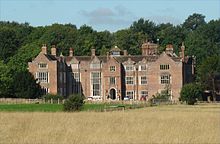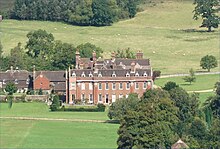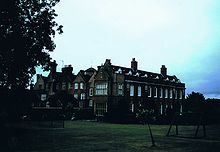Danny House
Danny House is a country house in the Elizabethan style in Hurstpierpoint in West Sussex . The red brick building sits at the north foot of Wolstonbury Hill and, with its 56 bedrooms and 28 apartments, is one of the finest state-owned buildings in Sussex. Today's country house, built by George Goring a little east of an older house in 1593–1595 , has been listed by English Heritage as a first-degree historic building. It is surrounded by a 32,000 m² garden.
Origin of name
The name "Danny" is probably the corruption of the Anglo-Saxon Dane (g) hithe , which means "valley and harbor".
history
Pre-Roman times
On Wolstonbury Hill (now owned by the National Trust and part of South Downs National Park ) are the remains of a Bronze Age hermitage . There is a large, man-made flat area on the west side of Wolstonbury that is believed to have been an Iron Age camp .
Roman time
The Sussex Greensand Way , a Roman road, runs east-west through Danny Park and shows as a break in the lines on the hill north of the country house. Today the road is a terrace on the slope, a ravine that leads down from the hill and a raised strip in the landscape that leads to a watercourse. A Roman earthenware kiln was found south of the Roman road.
Domesday Book
The Domesday Book of 1086 notes that “Robert holds Herst of William” (Eng .: Robert de Pierpoint received land from William de Warenne , the son-in-law of William the Conqueror )
13th Century
There has always been some house on this property since the 13th century, initially little more than his hunting lodge. The medieval Danny Park was fenced in in 1343 by Sir Simon de Pierpoint .
Late 16th century
The manor house in its current form dates from the beginning of the 16th century, but was rebuilt and enlarged by George Goring in 1593 after he had acquired the property in 1582. It was planned in the form of the letter "E", which was a symbol for Elizabeth I , who had ruled for over 30 years when the renovation work began. The country house is a particularly fine example of contemporary architecture.
The current house has two main facades, the 16th century east and Georgian-style south . The brick facade in the east is monumental, the southern facade supports the state. The whole building is a magnificent sight when viewed from the lowlands. It has three floors. There is a well-preserved ice house on the property .
Mid 17th century
After four generations of the Goring family, Danny House was sold to Peter Courthorpe in 1650 . In 1652 Danny Great Park was 54 hectares in size. With the surrounding fields and pastures, the area covered 170 hectares. In the parkland you can still find noble oaks of various ages and growth forms. It is used for recreation.
1702 married Barbara Courthope , granddaughter of Peter, Henry Campion and from 1725 they also lived in Danny House. Soon they started extensive renovations, including the construction of a new south facade, as can be seen from their initials and the year 1728 on the leaded water pipes. Several generations of the Campion family followed.
War Cabinet
During the First World War , Danny House was rented to Prime Minister David Lloyd George for six months . He lived there in a love triangle with his wife Margaret and his secretary and lover Frances Stevenson . Regular meetings of the war cabinet took place in the knight's hall. On October 13, 1918, the terms of the armistice offered to Germany were decided there and US President Woodrow Wilson was given the mandate to negotiate it with the Germans.
There were some letters from Lloyd George to Frances Stevenson that were written at Danny House. One of them reads: "My darling Pussy. You might phone from the Treasury on Friday if you can come. Don't let Hankey see you. If Saturday impossible, what about Monday? Fondest love to my own." (Eng .: My dearest pussy. You should call the Treasury on Friday if you come. Don't let Hankey catch you. If Saturday is impossible, what about Monday? Lots of love to mine…) D. (Hankey was cabinet secretary at the time )
Recent history
Soon after World War II , Danny House became a school, Montpelier College , which had been moved from Brighton . But the school was closed again in 1950. The Campion family no longer lived in the country house either, but they owned the property until the 1970s. Then it was broken up and many properties, houses and farms were sold or leased. The country house itself was sold to the Mutual Household Association (later Country Houses Association ). After this company was liquidated in 2003, Danny House was sold to Richard Burrows in 2004 . He turned it into serviced apartments for retirees, bed and breakfasts and a family business. In 2007, Danny House celebrated the 50th anniversary of its conversion into a retirement home.
swell
- Sussex County Magazine Volume 1, p. 457
- Country Life , March 22, 1913
Individual evidence
- ^ Danny, New Way Lane . English Heritage. Retrieved January 19, 2015.
- ^ ID Margary: Roman Ways in the Weald Phoenix House (Revised Edition) 1965. pp. 171–172.
- ↑ Historic houses to close . BBC News, December 15, 2003. Retrieved January 19, 2015.
Web links
Coordinates: 50 ° 55 ′ 9 ″ N , 0 ° 10 ′ 24 ″ W.


